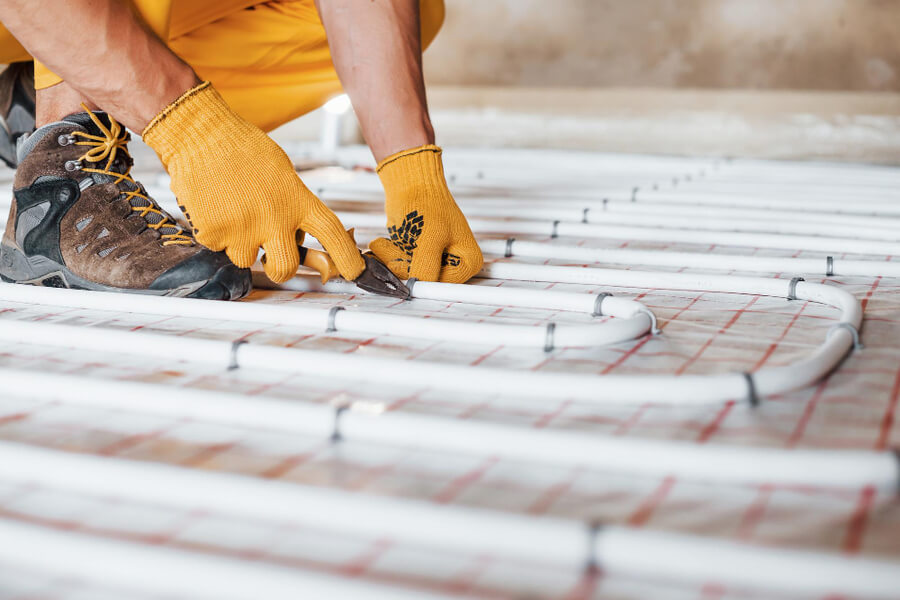
Underfloor heating is popular in many homes due to its modernity and efficiency. And if you’re wondering about investing, it’s natural to want to know what you’re getting into. Fortunately, we’ve gathered together some underfloor heating pros and cons that will help you if you’re considering investing in underfloor heating. For example, this heating option offers fantastic benefits, like improved energy efficiency, cosy comfort, and the freedom to get creative with your design choices. However, there are a few considerations, like installation costs, warm-up time, and the need to be mindful of furniture placement. So, let’s take a closer look at the pros and cons of underfloor heating and learn more about this wonderful heating solution.
How Underfloor Heating Works

Underfloor heating is a method of heating a space by installing heating elements directly beneath the floor surface. There are two main types of underfloor heating systems: electric and wet (water-based). Both of these underfloor heating systems rely on radiant heat transfer. Rather than heating the air directly, underfloor heating warms the objects and surfaces in the room, including the floor itself. This provides a more even and comfortable distribution of heat throughout the space.
Learn More: How Does Underfloor Heating Work?
Types of Underfloor Heating
As we mentioned, there are two types of underfloor heating that you can install in your home: electric or wet underfloor heating. As the name suggests, electric underfloor heating generates warmth with electrical elements. On the other hand, wet underfloor heating relies on heated water to provide warmth. Learn more about the differences between these types of underfloor heating below.
Electric Underfloor Heating
Electric underfloor heating systems rely on electric heating to provide warmth, offering a flexible solution for all types of floors. Depending on your electric underfloor heating system, they will heat your home using heating cables or heating mats.
- Heating Cables: Heating cables consist of electric wires installed beneath the floor surface. These cables are usually laid out in a predetermined pattern to ensure even heat distribution. They provide flexibility in terms of placement and are suitable for various floor types, such as tile, laminate, or carpet. Often, retrofit underfloor heating projects where the floor is already in place require heating cables.
- Heating Mats: Heating mats are pre-assembled sheets with embedded heating cables. These mats are easier to install as they come in fixed sizes and can be rolled directly onto the floor. Heating mats are suitable for large areas and commonly used in new construction projects. They are compatible with different floor coverings, including tile, stone, or engineered wood.
Electric underfloor heating systems offer quick, responsive heat-up times, allowing you to control the temperature in individual rooms. They are relatively easy to install and require minimal maintenance. However, they can be more expensive than other systems, particularly in larger spaces. But, more on electric underfloor heating pros and cons later!
Wet Underfloor Heating
As wet underfloor heating systems rely on heated water to warm up, they require a heat source. You can use a boiler or an underfloor heat pump for this job. This heat source warms the water circulating through the pipes, which are embedded in a screed or concrete layer beneath the floor.
What Are The Pros and Cons of Underfloor Heating?

As with anything, underfloor heating comes with its advantages and disadvantages. However, if you’re considering installing this heating solution, being aware of the pros and cons of underfloor heating will help you make the right choice. Here are some underfloor heating pros and cons for you to consider to make an informed decision.
Pros of Underfloor Heating
We’ve established that there are several pros and cons of underfloor heating that you need to consider, so it’s time to get stuck in. Underfloor heating has gained popularity as a modern and efficient heating solution with its numerous benefits. So, let’s find out why by shedding light on its advantages across various aspects.
Energy Efficiency
Underfloor heating offers notable energy efficiency advantages compared to regular heating solutions, providing various benefits for reducing energy consumption and costs. In addition, due to the enhanced heat distribution, lower operating temperatures, and individual room controls, underfloor heating runs very efficiently.
Underfloor heating can be up to 40% more energy-efficient than traditional radiator systems. Additionally, homeowners using underfloor heating in the UK typically only pay between £7 – £15 per month to run their underfloor heating.
Space Saving
Bulky radiators can take up more space than you realise. However, underfloor heating eliminates those large radiators and frees up your space. You can make the most of your wall space or push furniture items flush against the wall to open up the floor. Plus, with underfloor heating, you can be sure that everyone will still be toasty and warm no matter where you put your seats.
Suited To All Floor Coverings
Underfloor heating is the perfect solution for any room since you can install it under any floor covering. You can place underfloor heating under carpet, tile, wood, stone, laminate and almost any other floor type. So, if you’re planning a new build or looking to improve your current home, underfloor heating will be perfect no matter what. Don’t want to rip up your existing floor? Try retrofit underfloor heating systems for all the heat without the high-maintenance installation.
Easy To Install
Although installing an underfloor heating system may sound problematic, their installation is easier than you think. With professional assistance or top DIY skills, you can have underfloor heating running in your home for a maximum of two days. On the other hand, you can rapidly install some underfloor heating solutions, such as sticky mats, which just need to stick to the underfloor.
Comfortable Heating Experience
Underfloor heating systems offer a comfortable heating experience through various features. These systems provide even heat distribution, eliminating room cold spots and temperature variations. By operating without drafts or circulating dust particles, underfloor heating creates a pleasant environment, especially for individuals with allergies. The warmth from the floors adds to the cosy atmosphere, particularly during colder months. Additionally, underfloor heating operates silently, ensuring a peaceful ambience without disruptive noise.
Cons of Underfloor Heating

Although underfloor heating can bring many advantages to your home, there are some disadvantages that you should carefully consider. Many of the cons of underfloor heating relay back to the initial cost, but don’t forget that running underfloor heating works out cheaper than radiators. So, consider if the initial costs and other cons of underfloor heating outweigh your current situation.
Installation Costs
Initial costs for underfloor heating can be quite high, particularly the installation costs. Underfloor heating installation includes labour and material expenses and floor preparation where necessary, bumping the prices up.
The costs associated with underfloor heating installation in the UK can vary depending on system type, floor area, and project complexity. While providing precise figures without specific project details is challenging, considering estimated cost ranges is useful.
According to a UK’s National Energy Foundation study, the average cost of installing wet underfloor heating in a new build project ranges from £50 to £90 per square meter. However, for retrofit installations, where existing floors may require more preparation, the average cost can range from £70 to £120 per square meter. These estimates include both labour and material expenses.
Long Installation Period
The installation of underfloor heating systems can take longer than traditional heating systems. This is due to the complexity of fitting the heating elements, laying pipes, or installing electric mats beneath the floor. The duration of the installation process may vary depending on the system type, floor area, and the need for floor preparation. It’sConsidering this extended installation period when planning construction or renovation timelines is important.
Professional Installation
If you plan to install a wet underfloor heating solution, hire a professional installer. Installing wet underfloor heating requires a high level of skills and knowledge that many casual DIY enthusiasts may not possess, and you don’t want to cause any issues in your home during installation. So, it’s in your best interest to hire a professional. Unfortunately, this can raise the initial costs even more, with installation costs ranging from £120 – £135 per square metre.
Warm Up Time
Underfloor heating systems typically have a longer warm-up time than traditional heating methods such as radiators. This is because the heat generated from underfloor systems gradually radiates upward, which may result in slower room heating. This slower warm-up time might require more strategic planning to ensure the heating reaches the desired temperature at the right times, particularly in spaces requiring immediate warmth.
Furniture Restrictions
Underfloor heating can impose restrictions on furniture placement and selection. Since the heating elements are beneath the floor, bulky or heavy furniture can hinder the efficient distribution of heat. Also, placing furniture directly over the heating elements may obstruct heat flow and reduce the system’s effectiveness. So, you may have to reconsider your furniture arrangement and selection, plus leave sufficient space for heat circulation.
Pros and Cons of Underfloor Heating: In Conclusion

After examining the pros and cons of underfloor heating, it’s clear that this heating solution offers significant advantages alongside a few considerations. For those considering this heat solution, weighing the pros and cons of underfloor heating is crucial. By taking into account these points, you can be confident you are choosing the most suitable underfloor heating system for your needs.
FAQs
What are the advantages of underfloor heating?
The advantages of underfloor heating include consistent heat distribution, energy efficiency, comfortable heating experience, space optimisation, design flexibility, and reduced dust circulation.
Are there any disadvantages to underfloor heating?
Yes, underfloor heating has a few disadvantages, such as higher installation costs, longer warm-up time compared to radiators, and potential restrictions on furniture placement.
Is underfloor heating energy-efficient?
Underfloor heating is generally considered energy-efficient, as it provides radiant heat that warms objects and people directly, resulting in reduced heat loss and lower energy consumption.
Does underfloor heating improve air quality?
Underfloor heating can improve air quality by minimising the circulation of airborne allergens and dust particles, as there are no air vents or convection currents that distribute pollutants.
Is underfloor heating noisy?
Underfloor heating is virtually silent, as it operates without the need for noisy fans or blowers commonly found in other heating systems.
How long does underfloor heating typically last?
Underfloor heating systems typically have a long lifespan, with proper installation and maintenance. On average, they can last for 25 to 50 years, making them a durable heating solution for your space.
Resources
What does underfloor heating cost in 2023? | Checkatrade (2023) Checkatrade. Available at: https://www.checkatrade.com/blog/cost-guides/underfloor-heating-cost/ (Accessed: 24 May 2023).
Simply Switch. (2019). Underfloor Heating – How much does underfloor heating cost? [online] Available at: https://www.simplyswitch.com/energy/guides/underfloor-heating-is-it-right-for-you/ (Accessed: 24 May 2023).
VictoriaPlum.com. (2023). Can underfloor heating save you money? [online] Available at: https://victoriaplum.com/blog/posts/can-underfloor-heating-save-you-money [Accessed 24 May 2023].
Patrick (2021). Energy Saving in the Home. [online] National Energy Foundation. Available at: https://nef.org.uk/energy-saving-in-the-home/ [Accessed 24 May 2023].
